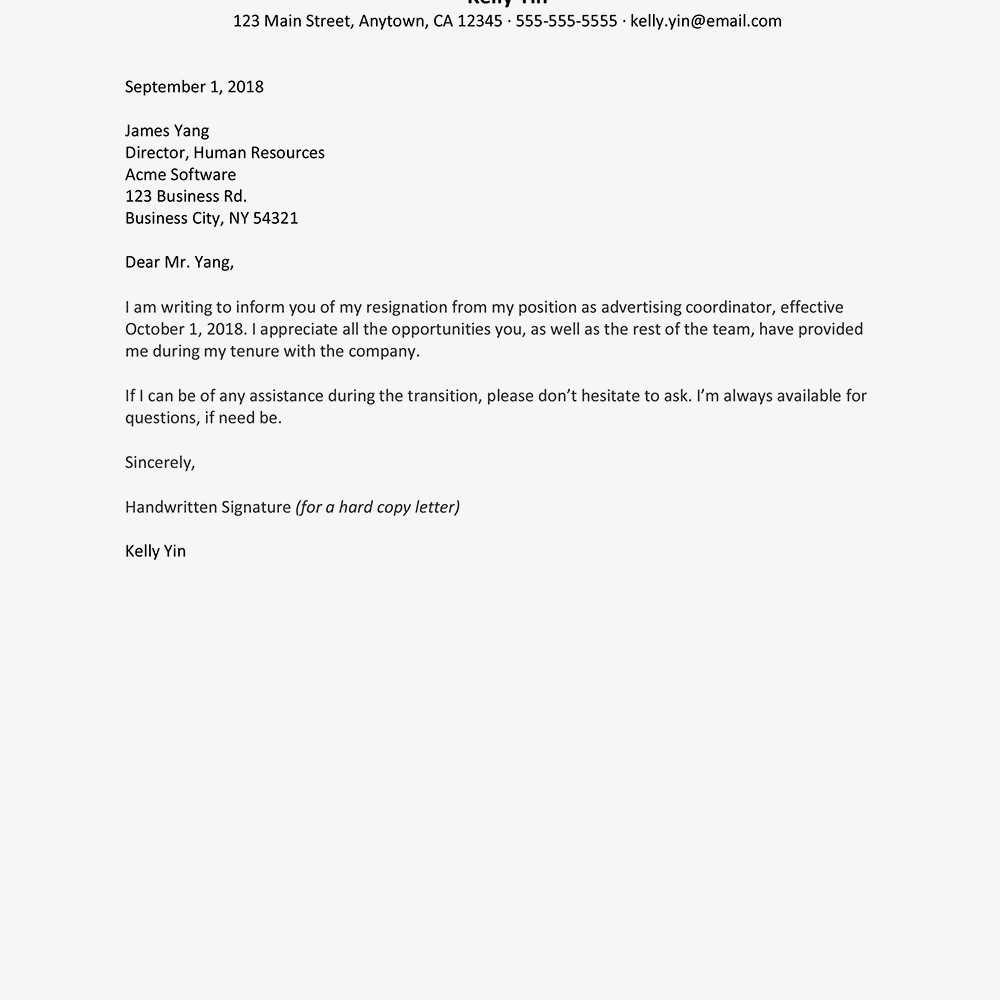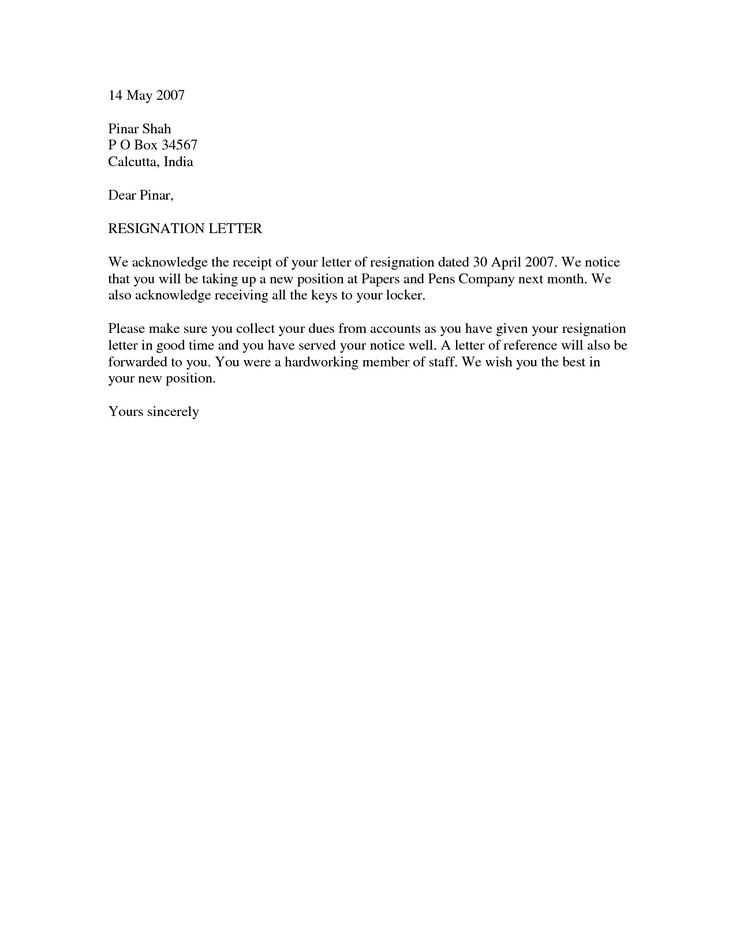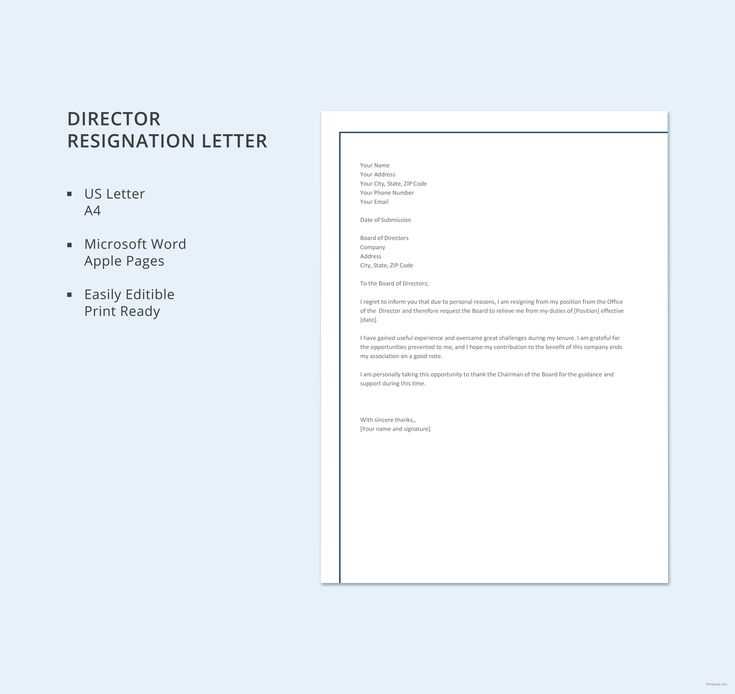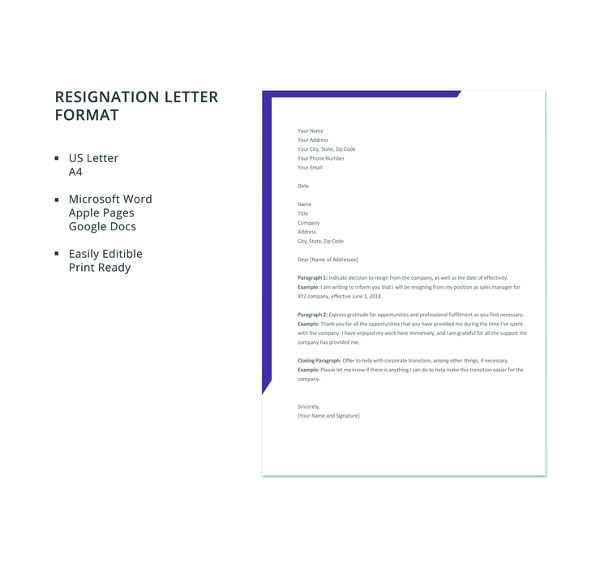Resign letter template word

When you decide to leave your job, it’s important to handle your resignation professionally. A well-crafted resignation letter can leave a positive impression, even after you’ve moved on. Start by being clear and direct in your intent to resign, and include the necessary details to ensure a smooth transition.
Use a resignation letter template in Word for a clean and professional layout. Customize it with your personal information, such as your current position, your last working day, and a brief mention of your reasons for leaving, if appropriate. Keep the tone respectful and courteous, even if your experience was less than ideal.
Be sure to express gratitude for the opportunity to work with the company. This simple gesture can maintain goodwill, which may prove valuable for future professional relationships. End the letter by offering assistance in the transition, such as training a replacement or providing documentation of your responsibilities.
Here are the revised lines:
Make sure your resignation letter is clear, concise, and polite. Avoid any overly emotional language or unnecessary details. Below are examples of how to structure your message:
-
“I am writing to formally resign from my position at [Company Name], effective [Date].”
-
“Please consider this my formal resignation, effective [Date].”
-
“I appreciate the opportunities I’ve had while working with [Company Name], but I have decided to pursue other career goals.”
-
“Thank you for the support and the valuable experience I gained during my time here.”
-
“I am happy to assist with the transition and will ensure a smooth handover of my responsibilities.”
Keep your tone respectful and professional, focusing on expressing gratitude and offering assistance where possible. This shows that you are leaving on good terms while maintaining professionalism.
- Resign Letter Template Word: A Practical Guide
To create a professional resignation letter, start with a clear structure. The first step is to mention your intention to resign, followed by the reason for leaving if appropriate. Keep the tone respectful and positive. Below is a simple example that you can modify to suit your needs:
Template Example
| Section | Content |
|---|---|
| Introduction | “Dear [Manager’s Name], I am writing to formally resign from my position as [Your Position] at [Company Name], effective [Last Working Day].” |
| Reason for Leaving | “This decision is based on personal reasons (or any specific reason you wish to state). I have enjoyed working here and appreciate the opportunities provided.” |
| Closing | “Thank you again for the chance to be a part of [Company Name]. I am committed to ensuring a smooth transition and will assist in any way during my remaining time.” |
Keep the letter brief and to the point. A resignation letter should remain polite and appreciative, even if you’re leaving due to negative circumstances. If you’re unsure about the exact wording, you can always check a template in Word format to get ideas for your letter’s layout and structure.
Opt for a clear and direct format that highlights your intent to resign, ensuring the tone remains professional and courteous. Begin with a formal greeting, followed by a concise statement of your resignation. Specify your last working day and express gratitude for the opportunity provided.
The body of the letter should remain brief, focusing on the necessary details. Avoid including personal issues or excessive explanation. Mention any transition plans or willingness to help during the handover period. End with a polite closing statement, leaving the door open for future communication.
Choose a standard business letter format, with a professional header and proper alignment. Use a simple, readable font and maintain a formal tone throughout. This ensures your letter is both professional and respectful, reflecting well on you as you move on to your next opportunity.
Open Microsoft Word and choose a blank document. This will provide you with a clean slate for your resignation letter.
1. Set the Format
Adjust the font size and style to a professional one, like Arial or Times New Roman, with a size of 11 or 12. Make sure your margins are set to 1 inch on all sides.
2. Include Your Contact Information
- Type your full name, address, phone number, and email at the top of the page.
- Make sure the information is aligned to the left.
3. Date the Letter

Below your contact details, include the current date. This is important for record-keeping and clarity.
4. Add the Recipient’s Information
- Enter your employer’s name, job title, and company name. Place this below the date, aligned to the left.
- Include the company’s address if needed.
5. Start with a Formal Greeting

Use a professional salutation, such as “Dear [Manager’s Name],” to begin the letter.
6. State Your Resignation
- In the first paragraph, clearly state that you are resigning and include your last working day.
- For example: “I am writing to formally resign from my position as [Your Job Title] at [Company Name], effective [Date].”
7. Express Gratitude
In the next paragraph, thank your employer for the opportunity to work with the company. Keep it brief and sincere.
8. Offer Assistance

- Consider offering help during the transition period, like training a replacement or completing pending tasks.
- This shows professionalism and willingness to contribute before you leave.
9. Close Politely
End the letter with a respectful closing statement, such as “Sincerely” or “Best regards.”
10. Proofread
Before sending, double-check your letter for grammar, spelling, and clarity. A well-written resignation letter reflects positively on you.
Once finalized, save your document and print it if necessary. Ensure that a digital copy is saved for your records.
Clearly state your resignation and specify the last working day. Avoid vague statements like “I’m leaving soon” or “I plan to resign.” Being precise about your departure date is critical for clarity.
Unprofessional Language
Avoid using negative or emotional language. Complaining about coworkers, management, or the company creates a poor impression. Keep your letter respectful and professional, even if you’re leaving under difficult circumstances.
Neglecting Transition Plans
Leaving out details about your transition process can leave a bad impression. Offer to help with handing over responsibilities or training a replacement. This shows your commitment to a smooth transition.
| Do | Don’t |
|---|---|
| State your resignation date clearly | Leave your resignation vague |
| Keep the tone professional | Express frustration or anger |
| Offer assistance with the transition | Ignore transition duties |
Begin by adjusting the tone of your resignation letter to match your relationship with the employer. If you had a positive experience, express gratitude. For a more formal resignation, maintain a professional tone throughout the document. A simple change in phrasing can make a big difference in how your letter is received.
Include Specific Dates
Modify the template by adding your exact resignation date and notice period. Make sure it aligns with your contract or company policy. By doing this, you clarify expectations and provide a clear timeframe for the transition.
Explain the Reason for Leaving (Optional)
If appropriate, include a brief reason for your resignation. You don’t need to go into great detail, but offering context can help maintain positive relations. Keep it neutral and professional, avoiding negative comments about the workplace.
Review the details of your resignation letter, ensuring that it accurately represents your circumstances and intentions. Personalization allows for clarity and professionalism, increasing the chances of a smooth transition out of your role.
Use a clean, easy-to-read font like Arial or Calibri, sized between 10-12pt. This ensures clarity and enhances readability. Avoid decorative fonts or large text sizes that could distract from the content.
Align your text to the left for better structure. Centered text can appear unprofessional in most formal documents. For headings, use bold text to distinguish them from body content, but keep the font size consistent with the rest of the document to avoid excess emphasis.
Keep margins at 1 inch on all sides. This standard spacing provides a balanced layout and ensures that text is neatly contained within the page. Adjust spacing between paragraphs to 6pt to maintain readability without overcrowding the page.
Incorporate bullet points or numbered lists for clarity, but limit them to key information only. This will organize your thoughts and make your letter easier to scan quickly.
Finally, use the line spacing tool to set your document to 1.15 or 1.5 line spacing. This helps avoid a cramped look and makes your letter more inviting to read.
Save your resignation letter in a widely accessible format like PDF to preserve its layout and ensure it can be opened on any device. This prevents issues with different word processing software or versions, keeping your letter professional and consistent.
Before sharing, ensure your letter is clear, concise, and free from errors. If you are using Microsoft Word or Google Docs, double-check the formatting, as it can occasionally change when transferring between platforms. Save the file in PDF format to prevent these issues.
For sharing, email is the most common and secure method. Attach the letter to your message and include a brief note in the body, explaining your intention and the official submission. Ensure the subject line is clear, such as “Resignation Letter – [Your Name].”
Consider including the recipient’s name in the file name for easy identification, e.g., “Resignation_Letter_John_Smith.pdf.” This helps your employer locate it quickly, avoiding unnecessary confusion.
If needed, you can also share the letter via a cloud service like Google Drive or Dropbox, but always make sure the access permissions are set correctly to ensure the privacy of your document.
Now, word repetition is minimized while the meaning is preserved.
Start your resignation letter by clearly stating your decision to leave. Avoid unnecessary explanations. A simple, direct statement works best. Follow up with a brief mention of your last working day, ensuring clarity for both you and the employer.
Express gratitude for the opportunity without overdoing it. Acknowledge the experiences you gained, but keep it brief and genuine. Offer to assist with the transition if applicable, but avoid sounding overly apologetic or obligated.
Conclude by wishing the team or company continued success. Keep the tone positive and professional, focusing on a smooth exit. This will leave a lasting impression without overloading your message with unnecessary information.